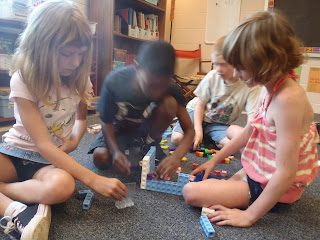To practice adding rich details to our own writing, we've been using our keen observation skills to focus in on
specific details.
 |
| Lucas brought in this abandoned bird's nest to share with our class. |
We took some time to carefully inspect the nest, recording specific information that we noticed on our observation sheets. We used our five senses to help us get as many details as possible. (Don't worry, we just imagined what it might taste like!)
Once we were finished with our notes, we moved back to our seats to begin writing a descriptive poem about this nest, using the details we recorded.
Then, we shared our poems with a partner. We gave them feedback by commenting on something we liked about their poem.
Finally, we chose some lines from our poetry to combine into a class poem. We were
really impressed with some of the poets we have in our classroom!
 |
| Maddie said, "Kasia, how do you think of sentences like that?" | | |
And this is our final draft:
The Bird's Nest
Feeling wind against
my feathers high in the treetop.
It whistles through
my ears.
The rough, delicate
nest is made out of any materials that I can find.
Bent twigs and sticky
mud,
Dried up leaves and
soft, squishy moss.
Up so high, it keeps
my chicks safe while I hunt for worms and scrumptious, crunchy bugs.
New baby birds,
pecking frantically to break free of their eggs.
Rumbling and squeaking,
the babies are hungry.
Mama bird shrieks to
say, “I’m back!”
It’s not easy for
birds to take care of their young.
Even though bird’s
nests are fascinating, it’s important to respect them.
Let them be.



























































